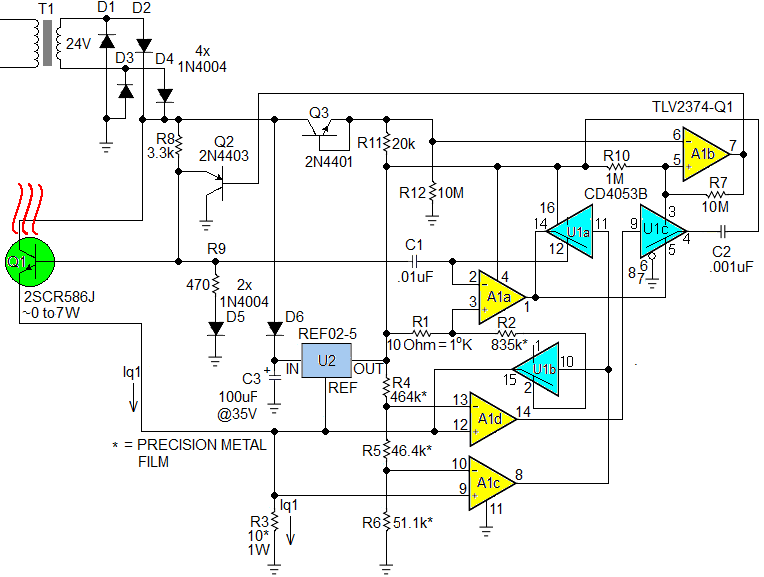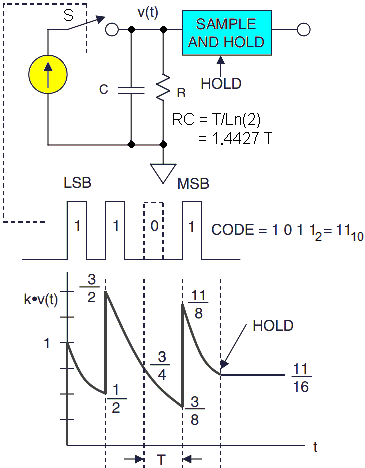
Self
- Analog
- 2023-09-23 21:19:38
It’s just an unavoidable fact: electronic components’ parameters drift with temperature. Even the most stable voltage references, op amps, crystal oscillators, etc., have non-zero temperature coefficients. These effects can be mitigated by various compensation methods, but in particularly picky applications the best (only) solution may be a constant-temperature component oven.
Ovens tend to be relatively large and energy intensive, so they’re tricky to fit into miniature, power-efficient designs. The thermostat design presented (Figure 1) here can’t eliminate these problems, but it minimizes both.

Figure 1 The self-heated transistor ∆Vbe based thermostat with a multiplexing bipolar power transistor for temperature control, close coupling of the thermostat transistor to the component that requires temperature control, and ∆Vbe sensing for temperature measurement.



Wow the engineering world with your unique design: Design Ideas Submission Guide
It incorporates three ideas.
Multiplexing a bipolar power transistor between temperature self-measurement and self-heating, thereby self-controlling its temperature.Close thermal coupling of the thermostat transistor to the component that needs temperature control. Thus, when the transistor thermostats itself, it also thermostats the component thermally bonded to it.Utilizing ∆Vbe sensing to get accurate and calibration-free measurement of the transistor’s absolute (Kelvin) temperature, thereby facilitating an accurate temperature setpoint [1].An obvious alternative method, using transistor Vbe tempco for temperature self-sensing, is appealing due to its apparent simplicity, but in practice its utility is limited by unpredictable transistor to transistor Vbe variability. In reference 1, famed analog guru Jim Williams explained how this problem necessitates initial sensor transistor calibration (and recalibration if the sensor ever needs replacement).
But then he saved the day with an ingenious solution.
It turns out, wrote Jim, that although the constant-current Vbe of a random transistor isn’t usefully predictable, BJT Vbe change with variable-current is very predictable. Specifically, it reliably obeys this simple logarithmic equation…
∆VBE = Tabs LOG10(I2/I1) / 5050
Where Tabs = absolute temperature in oKelvin. Therefore, when used as a thermometer…
Tabs = ∆VBE 5050 / LOG10(I2/I1)
Note, that easily remembered “fifty-fifty” constant!
In this thermostat application I2/I1 = 2, so…
∆VBE = Tabs LOG10(2) / 5050 = 59.61 µV/ oK
Figure 2 shows two 8.33 ms cycles of thermostat operation. Each corresponds to a half-cycle of the 60 Hz AC mains (50 Hz would also work) and thus they repeat at 120 Hz and comprise four steps.

Figure 2 Temperature measurement/control cycle with two 8.33 ms cycles of thermostat operation where each of these cycles consists of four steps: autozero, setpoint compare, heat/cool and A1d reset.
Step #1: Autozero comprises the ~520 µs interval required for Q1’s emitter current Iq1 to rise from zero to ~50 mA as sensed by R3 and comparator A1c, against a precision 500 mV threshold voltage provided by 5.00 V reference U2 and the R4, R5, R6 divider network. During this step, the A1c pin 8 is low, configuring switches U1a and U1b to cause auto-zero of A1a. Autozero of A1a is useful because of the low amplitude (<60 µV/oK) of the ∆Vbe signal compared to A1’s (2 mV typical, 4.5 mV max) Vos offset voltage. Without correction, this would imply an (unzeroed) temperature measurement error of 33oK to 75oK. Acquiring, holding, and thus subtracting out A1a’s Vos on C1 avoids this intemperate fate.
Autozero ends at Iq1 = 50 mA forcing Vr3 = 500 mV driving A1c pin8 = 0 and beginning the Setpoint Compare step.
Step #2: Setpoint Compare occupies the next 520 µs while Iq1 doubles from 50 mA to 100 mA, producing the aforementioned I2/I1 = 2 and thus a 59.61 µV/ oK temperature-measurement Vbe delta. A1a compares this to the programmed temperature setpoint with setpoint bias resistor R2 scaled so that…
Vr1 = 5.96 µA x R1R1 = T (setpoint) oK x 10 Ω
Here are some example R1 values for selected setpoint temperatures (closest standard resistor values)…

The result (T > or < than setpoint) of the comparison step is sampled and held on C2.
Step #2 ends at Iq1 = 100 mA and Vr3 = 1 V, driving the A1d pin 14 low and causing switch U1c to transfer Vc2. Thus, the result of the Vbe delta setpoint comparison to bistable A1b. The control signal goes from there to heating enable/disable transistor Q2’s base.
Step #3: Heat/Cool spans most of the remainder of the AC half-cycle, corresponding to the T
Step #4: A1d reset uses AC zero crossings to reset the A1d latch every 8.33 ms via diode connected Q3, in preparation for another thermostasis cycle.
In closing, I should mention a caveat-emptor type thing about trying to make a ∆Vbe temperature measurement work with power transistors generally: mostly it doesn’t.
Although most small signal transistors inherently conform well to the logarithmic relationship described by Williams, many (maybe most) power transistors definitely do not. Fortunately, the Rohm 2SCR586J is a happy exception and accurately obeys the “5050” arithmetic.
Frankly, if I hadn’t found it, I wouldn’t be writing this article.
Reference
page 7 AN45 Measurement and Control Circuit Collection (Diapers and Designs on the Night Shift). https://www.analog.com/media/en/technical-documentation/application-notes/an45f.pdfStephen Woodward’s relationship with EDN’s DI column goes back quite a long way. In all, a total of 64 submissions have been accepted since his first contribution was published in 1974.
Related Content
Transistor ∆VBE-based oscillator measures absolute temperatureSelf-heated Darlington transistor pair comprises new air flow sensorNonlinearities of Darlington airflow sensor and VFC compensate each otherLinearized portable anemometer with thermostated Darlington pairSelf由Voice of the EngineerAnalogColumn releasethank you for your recognition of Voice of the Engineer and for our original works As well as the favor of the article, you are very welcome to share it on your personal website or circle of friends, but please indicate the source of the article when reprinting it.“Self”










